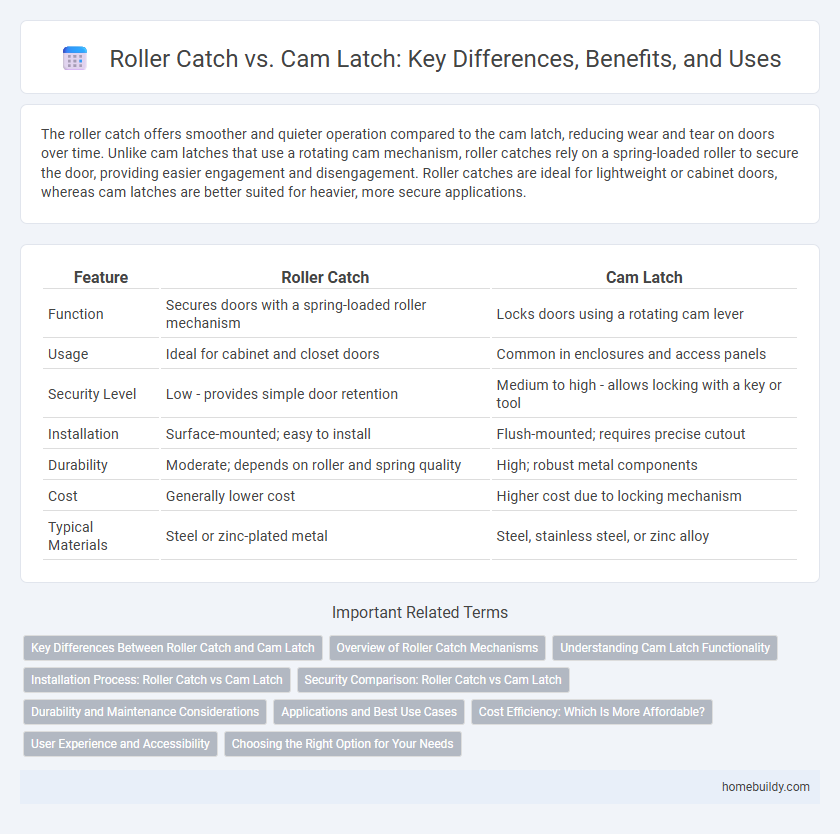The roller catch offers smoother and quieter operation compared to the cam latch, reducing wear and tear on doors over time. Unlike cam latches that use a rotating cam mechanism, roller catches rely on a spring-loaded roller to secure the door, providing easier engagement and disengagement. Roller catches are ideal for lightweight or cabinet doors, whereas cam latches are better suited for heavier, more secure applications.
Table of Comparison
| Feature | Roller Catch | Cam Latch |
|---|---|---|
| Function | Secures doors with a spring-loaded roller mechanism | Locks doors using a rotating cam lever |
| Usage | Ideal for cabinet and closet doors | Common in enclosures and access panels |
| Security Level | Low - provides simple door retention | Medium to high - allows locking with a key or tool |
| Installation | Surface-mounted; easy to install | Flush-mounted; requires precise cutout |
| Durability | Moderate; depends on roller and spring quality | High; robust metal components |
| Cost | Generally lower cost | Higher cost due to locking mechanism |
| Typical Materials | Steel or zinc-plated metal | Steel, stainless steel, or zinc alloy |
Key Differences Between Roller Catch and Cam Latch
Roller catches use a spring-loaded roller to secure doors, providing silent and smooth engagement, while cam latches rely on a rotating cam mechanism to hold panels firmly in place. Roller catches are ideal for lightweight doors and offer easier adjustment but less security, whereas cam latches deliver stronger locking force suited for access panels and cabinets requiring frequent operation. The choice depends on the desired balance between ease of use, noise level, and holding strength for the application.
Overview of Roller Catch Mechanisms
Roller catch mechanisms use spring-loaded rollers to securely hold doors or panels in place, offering smooth engagement and disengagement with minimal noise. Compared to cam latches, roller catches provide a more subtle and less intrusive locking method, ideal for lightweight doors or cabinets. Their design allows for easy installation and adjustment, enhancing functionality in residential and commercial applications.
Understanding Cam Latch Functionality
A roller catch uses a spring-loaded roller to secure doors by engaging with a strike plate, offering smooth engagement and easy release, whereas a cam latch operates through a rotating cam that locks into place, providing a more robust and secure fastening mechanism. Cam latches are typically employed in applications requiring strong holding power and precise alignment, such as cabinets and enclosures, whereas roller catches are favored for lighter doors or panels needing frequent access. Understanding cam latch functionality involves recognizing its rotational action that tightens the door against a frame, ensuring tighter closure compared to the flexible catch of a roller mechanism.
Installation Process: Roller Catch vs Cam Latch
Roller catches offer a straightforward installation process, typically requiring minimal tools and adjustments, making them ideal for quick door securing solutions. Cam latches involve a more precise alignment and mechanical assembly, often necessitating additional drilling and mounting hardware for proper functionality. Selecting between roller catches and cam latches depends on installation complexity, with roller catches favoring ease and cam latches prioritizing secure engagement.
Security Comparison: Roller Catch vs Cam Latch
Roller catches provide moderate security by using spring-loaded rollers that hold doors closed with pressure, making them suitable for interior applications where high security is not critical. Cam latches offer enhanced security through a rotating cam mechanism that firmly secures the door, making them ideal for exterior or high-security areas requiring resistant locking. The solid engagement and potential for lock integration in cam latches surpass the limited holding force of roller catches, ensuring better protection against forced entry.
Durability and Maintenance Considerations
Roller catches offer enhanced durability due to their simple design and fewer moving parts, reducing wear over time compared to cam latches. Maintenance requirements for roller catches are minimal, often involving just periodic lubrication, while cam latches may need more frequent adjustments and part replacements due to their complex mechanisms. Choosing roller catches can result in lower long-term maintenance costs and improved reliability in high-use applications.
Applications and Best Use Cases
Roller catches excel in applications requiring smooth, quiet door operation and moderate holding force, such as interior cabinet doors and lightweight closet doors. Cam latches are ideal for securing enclosures needing strong, adjustable clamping force, including toolboxes, electrical panels, and industrial cabinets. Choosing between roller catches and cam latches depends on whether ease of access or secure locking is the primary requirement.
Cost Efficiency: Which Is More Affordable?
Roller catches typically offer a more affordable solution compared to cam latches due to their simpler design and fewer moving parts, reducing manufacturing and maintenance costs. Cam latches involve more complex mechanisms and materials, leading to higher initial expenses but potentially increased durability for heavy-duty applications. Evaluating the total cost of ownership, including installation and longevity, is essential to determine the most cost-efficient option for specific door or cabinet needs.
User Experience and Accessibility
Roller catches offer smoother operation and quieter engagement, enhancing user experience by reducing noise and effort during door closure. Compared to cam latches, roller catches require less precise alignment, improving accessibility for users with limited dexterity or mobility. The simplicity of roller catches also results in fewer mechanical failures, providing a more reliable and user-friendly solution.
Choosing the Right Option for Your Needs
Roller catches provide smooth, quiet engagement ideal for lightweight or frequently accessed doors, while cam latches offer secure locking suitable for heavier doors or applications requiring higher security. Consider door weight, usage frequency, and security needs when deciding between a roller catch and a cam latch. Selecting the right option ensures optimal functionality and durability tailored to your specific door hardware requirements.
Roller catch vs Cam latch Infographic

 homebuildy.com
homebuildy.com